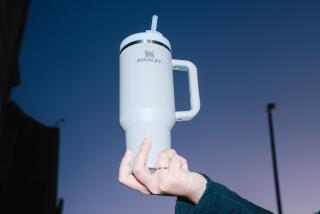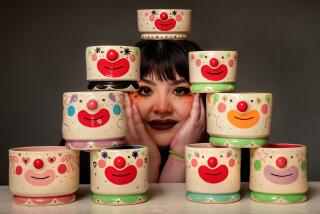Lalique’s Allure Is Crystal Clear: It’s in the Touch
- Share via
I like Waterford crystal very much, but I have a poor history with it, as I suspect many of us do who have ever handled that substantial yet brittle stemware. I have personally broken two fine Waterford wine goblets, both of which belonged to someone else and both of which were full of red wine at the time.
The first one slipped from my grasp in a porcelain tile-floored kitchen and shattered with such utter finality and into such tiny shards that I thought a form of contact explosive had somehow been blown into the glass. It was a high-pitched, rattling crash, and it silenced all conversation for blocks.
I dropped the second glass--a particularly ornate and beautiful one--on a deep-pile carpet. Watching the Zinfandel cascade toward the carpet was bad enough, but seeing the goblet blow to pieces burned the very soul to cinders.
In both cases, the hostesses who owned the glasses gritted through twitching smiles that all was well. Still, when they brought me more wine it was in a glass made from the same material they use to make Flintstones drinking mugs.
What is it about crystal that makes us fatally hesitate, that causes us to abandon our normal, fluid, unconcerned, habitual, everyday movements and start acting like we’re defusing a land mine? Why do we handle it as if it were a sleeping snake? Why do we not realize that it’s wine we’re drinking and not nitroglycerin?
Don’t ask Marie-Claude Lalique. She probably wouldn’t understand. She handles crystal as often and as easily as the rest of us handle the TV remote. As the third and latest generation of Laliques to run the famous French crystal business that bears the family name, she never hangs out the “don’t touch” sign when the crystal is on display. Exactly the opposite.
“I love it as an object, something to have around me day to day,” she said in a recent interview in Newport Beach, where she had arrived to autograph Lalique crystal pieces at an exhibit at Fashion Island’s I. Magnin store. “My concept of the design is based on my wanting to have it around myself, to touch, and not in a glass case.”
Lalique crystal, she said, has always been made with the eager human touch in mind, and an inventory of any display of Lalique will confirm that. While Lalique does make stemware and other table vessels, that is not the main body of work done at the factory in Wingen-sur-Moder in Alsace. While Waterford is, for the most part, made to be functional, Lalique is often made for show.
The first piece of Lalique crystal to gain wide fame was a perfume bottle Marie-Claude’s grandfather Rene fashioned for Coty in 1907. It was such a success that he began to produce many other glass sculptures, using a power press that had been used for vessels such as milk bottles and medicine jars.
By 1933, the Lalique line contained more than 1,500 items, including fountains, furniture, doors, chandeliers and architectural components. Several original designs are still being produced.
Rene’s son, Marc, took over the stewardship of the company when Rene died in 1945, and when Marc died in 1977 his daughter, Marie-Claude, became the company’s president and chief designer.
Lalique glass was not actually crystal until Marc introduced lead into the designs. Rene’s pieces were often satiny in character and used color introduced into the glass (a process that Marc abandoned in favor of leading).
Today, Marie-Claude uses both the brilliance of the leading process and the addition of color in newer designs, while the factory continues to produce many of the older, more familiar ones designed decades ago.
One of the more striking examples is Marc Lalique’s “Cactus Table,” designed in 1951. Eight individual crystal cactus fronds are bolted together on a base of crystal and metal, and a separate circle of beveled glass rests on top of this framework. It weighs a ton and retails for $68,000. (Yes, the stuff does appreciate: when the table was introduced, it went for around $5,000.)
Even smaller Lalique pieces have heft. They beg to be picked up, particularly if you like feeling the contours of the older frost-finished pieces. If you’re worried about dropping them, you might remember that back in the days when elegant cars had custom hood ornaments, Lalique routinely produced between 20 and 25 different types (some of which are still manufactured as decorative items for the home).
So go ahead. Pick them up and play with them. Marie-Claude Lalique certainly won’t mind. She says that she makes sure to rotate her personal collection so that no one sees the same piece displayed in her home twice.
I noticed, however, that she stopped short of inviting me over for drinks.
More to Read
Eat your way across L.A.
Get our weekly Tasting Notes newsletter for reviews, news and more.
You may occasionally receive promotional content from the Los Angeles Times.










